| Author |
Message |
|
Lukas MG
Industry Professional
|
 Posted: Mon 14 Jul, 2014 1:32 pm Post subject: Mail vs sword: a test Posted: Mon 14 Jul, 2014 1:32 pm Post subject: Mail vs sword: a test |
 |
|
Hey everybody,
I thought you might find this interesting. Similar tests have been done in the past but I figure, another view doesn't hurt.
Anyway, yesterday I had the opportunity to test two swords against some decent quality import mail from India. The mail was made of flat mild steel rings, riveted, about 9mm in diameter. Thickness of the rings was about 2mm.
For the thrusting tests, the mail was draped over bales of straw. I tested two swords against the mail, the XVIIIb longsword I recently made and a XII sword with a reground ATrim blade.
Fist up was the longsword. It has a narrow, pretty thick and reinforced needle point:
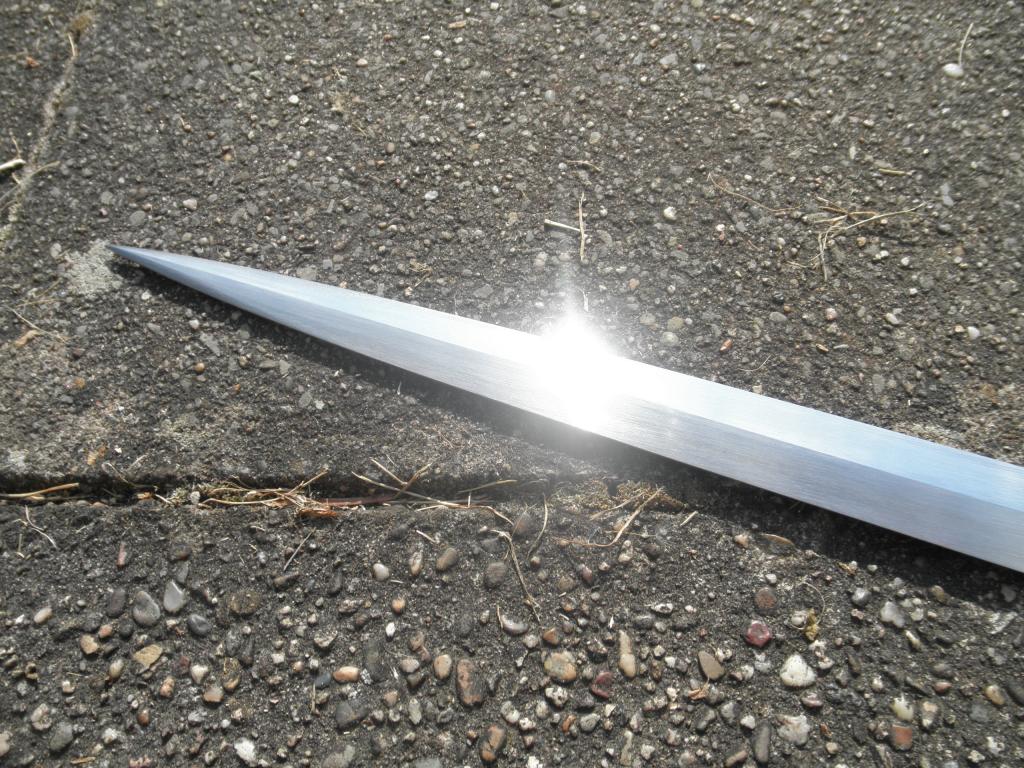
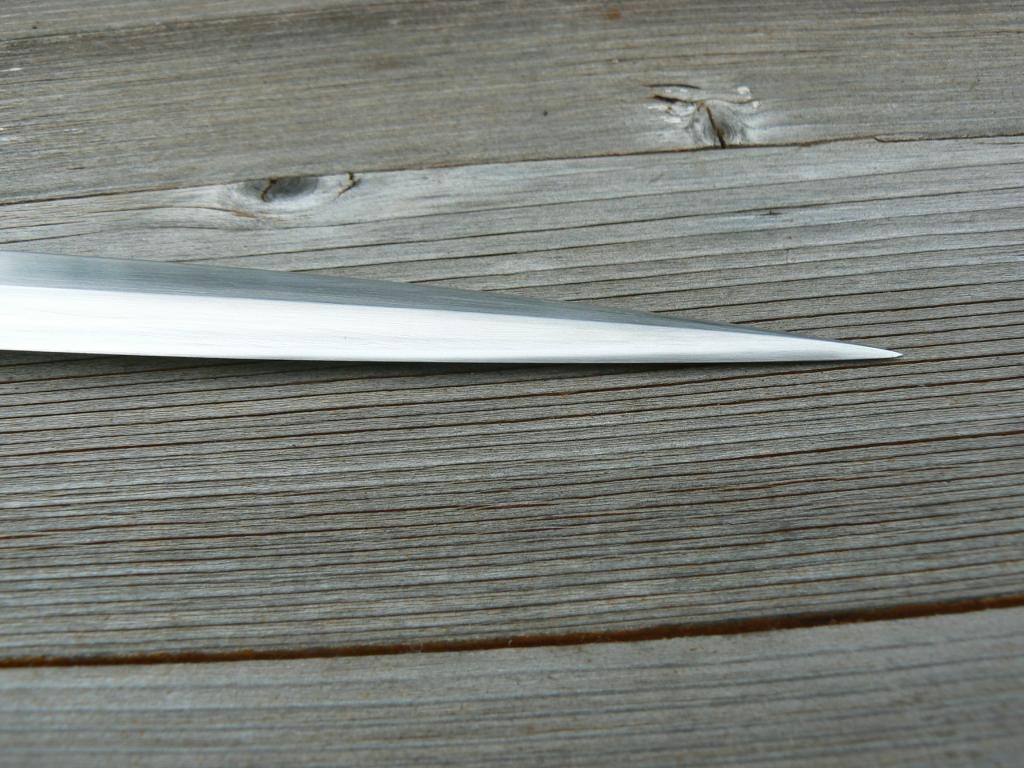
Using a half sword grip, a moderately strong thrust easily broke through the mail and penetrated 10cm in the straw. The tip burst one ring at the rivet, cut another one open and bent two or three more. A stronger thrust, even in a normal grip, would have been even more devastating I think. The blade didn't show a mark, only some shaved off material from the rings was visible on the sword's edges.
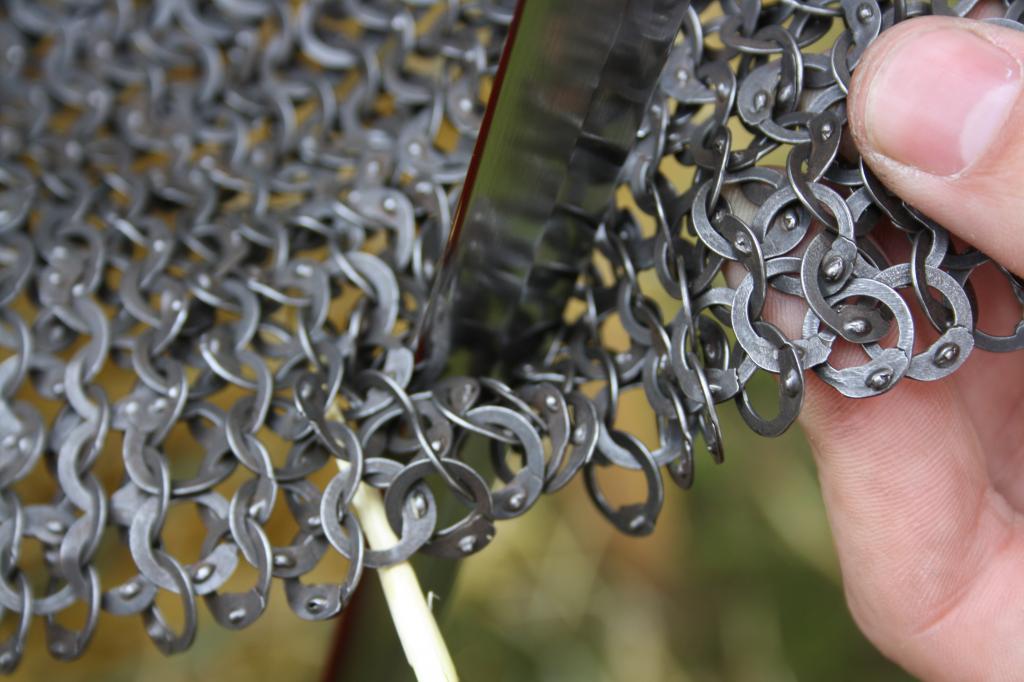

Next up the XII. I don't have a pic of its tip but it's typical for the time, very sharp but rather round and of lenticular cross section. This is pretty much what it looks like (courtesy of Mike Harris, this is an AT XII.2):
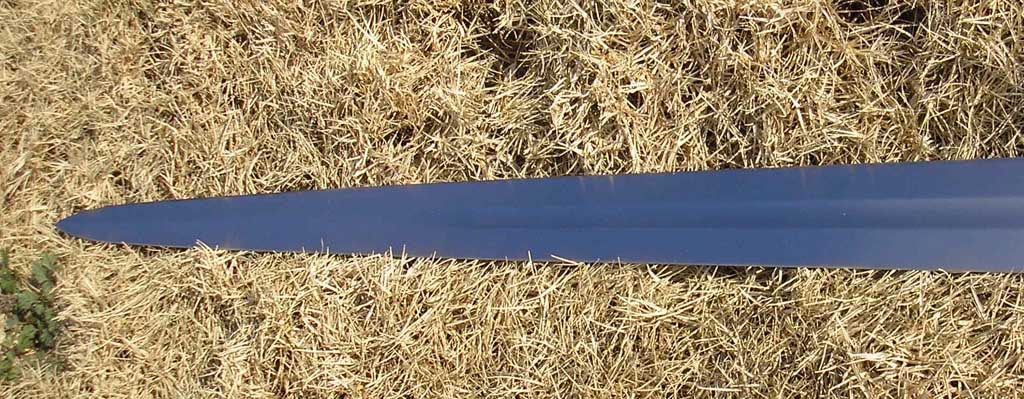
With a normal grip, I thrust three times into the mail. Result: not a thing. A couple light scratches on the rings and a very faint mark on the blade, practically invisible. No pics as you wouldn't see anything anyway. The XII I used is pretty stiff for its type so while certainly some energy was lost due to flexing, even had I (incorrectly) half sworded the blade to stiffen it, the result would be no different.
Reflection:
Against the round sword tip of its time, the mail was absolutely proof. Thrusts don't accomplish anything and cuts obviously stand even less of a chance to penetrate. Of course, blunt trauma shouldn't be ignored but overall, mail must have been a quite a formidable defense in its high time. The narrow and thick needle point of the later period sword (or bodkins for that matter) however make short work of the mail. While the mail used wasn't top of the shelf stuff, I still consider the test valuable. Better quality mail might have made it harder for the longsword to pierce it, the result for the XII would have been the same. Besides, I doubt all mail back then was created equal so while some might have been better, some probably performed pretty similar to what I was using.
Anyway, hope you find this interesting.
Last edited by Lukas MG on Mon 14 Jul, 2014 3:33 pm; edited 2 times in total
|
|
   |
 |
|
Mart Shearer
|
 Posted: Mon 14 Jul, 2014 2:40 pm Post subject: Re: Mail vs sword: a test Posted: Mon 14 Jul, 2014 2:40 pm Post subject: Re: Mail vs sword: a test |
 |
|
| Lukas MG wrote: | | The mail was made of flat mild steel rings, riveted, about 9mm in diameter. Thickness of the rings was about 2mm. |
For reference, do you mean 9mm internal diameter, with an outer diameter of around 13mm? When you say the rings thickness, do you mean width or depth: Vegard Vikes D1 or D2?
 Attachment: 12.68 KB Attachment: 12.68 KB
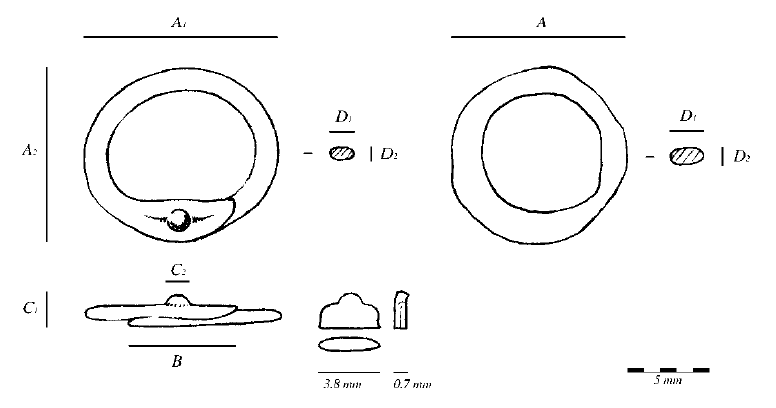
ferrum ferro acuitur et homo exacuit faciem amici sui
|
|
  |
 |
Dan Howard

|
 Posted: Mon 14 Jul, 2014 2:46 pm Post subject: Posted: Mon 14 Jul, 2014 2:46 pm Post subject: |
 |
|
There is no such thing as "decent quality import mail from India". These costumes are completely unsuitable for weapons testing.
http://www.myArmoury.com/talk/viewtopic.php?t=19189
Indian mail was specifically designed for the SCA market and intended to resist nothing more substantial than a rattan stick. It is lighter and stronger than the butted mail that re-enactors used to wear but that is all that can be said for it.
Author: Bronze Age Military Equipment, Pen and Sword Books
|
|
  |
 |
|
Lukas MG
Industry Professional
|
 Posted: Mon 14 Jul, 2014 3:03 pm Post subject: Posted: Mon 14 Jul, 2014 3:03 pm Post subject: |
 |
|
About 9mm internal diameter. With 2mm I meant D1 though this varied a bit, ranging from 3.5-4mm where the rivet was to 2-2.5mm for the rest. D2 was about 1mm, again a bit thicker at the rivet.
@Dan Howard: I am aware that period mail differs a bit and might have been superior in its performance. I still find it interesting that even the "cheap Indian mail" stopped thrusts from a XII without any problem. As I wrote, better mail would have made it harder for the longsword but changed nothing for the XII and the interesting thing here is the mail's performance against the sword it would have faced in battle...
|
|
   |
 |
Dan Howard

|
 Posted: Mon 14 Jul, 2014 3:41 pm Post subject: Posted: Mon 14 Jul, 2014 3:41 pm Post subject: |
 |
|
It doesn't "differ a bit". They were intended for completely different purposes. One is a costume. The other is intended for warfare. The sooner people realise that the better. We don't give police officers leather jackets and pretend that they are anti-ballistic vests even though they might stop an occasional bullet. This subject has been discussed for over a decade and I thought that we were finally getting somewhere but apparently not
Author: Bronze Age Military Equipment, Pen and Sword Books
|
|
  |
 |
|
Mike Ruhala
Location: Stuart, Florida Joined: 24 Jul 2011
Posts: 335
|
 Posted: Mon 14 Jul, 2014 8:59 pm Post subject: Posted: Mon 14 Jul, 2014 8:59 pm Post subject: |
 |
|
Thanks for the test, Lukas! I was thinking about getting loose links from that same supplier and making my own shirt but now I think I'll try something else. Also, halfswording with single handed swords can be seen in early artwork so I don't think it's unreasonable to test it with the XII.
Stronger, historically accurate mail at an affordable price would be really nice. Is there anything we can do to make that happen? I'd be happy with DIY links and knitting my own.
|
|
  |
 |
Dan Howard

|
 Posted: Mon 14 Jul, 2014 9:06 pm Post subject: Posted: Mon 14 Jul, 2014 9:06 pm Post subject: |
 |
|
The Indian mail is fine for what it was intended for - re-enactment costumes and SCA combat. Some of it even holds up when used in rebated steel combat. But if you want something to stop weapon points then you either make your own riveted links or purchase welded mail. If you want mail that looks like a particular museum example or to restore a museum piece then you go to a specialist like Erik. If you want to study how historical mail worked against historical weapons then you also need to go to a specialist like Erik.
Author: Bronze Age Military Equipment, Pen and Sword Books
|
|
  |
 |
|
Mike Ruhala
Location: Stuart, Florida Joined: 24 Jul 2011
Posts: 335
|
 Posted: Mon 14 Jul, 2014 9:17 pm Post subject: Posted: Mon 14 Jul, 2014 9:17 pm Post subject: |
 |
|
|
Right now sure but they're just pieces of metal, no reason people in India can't shape pieces of metal differently if they can be convinced to do so. There's definitely a market for better pre-made links.
|
|
  |
 |
|
Edward Lee
|
 Posted: Tue 15 Jul, 2014 12:31 am Post subject: Posted: Tue 15 Jul, 2014 12:31 am Post subject: |
 |
|
I have a welded mail hauberk and it could stand up to a thrust. The problem is if I were to be elusive then it would work, but if I lie down then it will definitely go through.
I've seen some mail at the Met museum, are those authentic mail or just reproductions? They look rather small and there is almost no gap to them. This one is not European but I wonder if they were identical?
https://www.flickr.com/photos/108451978@N06/13787131415/
|
|
  |
 |
|
Lukas MG
Industry Professional
|
 Posted: Tue 15 Jul, 2014 12:48 am Post subject: Posted: Tue 15 Jul, 2014 12:48 am Post subject: |
 |
|
Are you sure, all Indian mail is created equally bad? Pretend I hadn't said anything about where the mail was from... wouldn't you have expected the mail to perform just the way it did? Proof against the sword it would have encountered, not enough protection against later swords and similarly shaped arrow heads, etc... that's EXACTLY what you would expect. In fact, Mike Edelson got very similar results using very high quality mail: http://www.myArmoury.com/talk/viewtopic.php?t=11131
His Albion Talhoffer performed pretty much exactly like the longsword I used. So I don't believe this stuff is as bad as you make it out to be. Maybe the quality of Indian mail generally got better, or this one just is superior to most.
Regarding the "intended for costume, not warfare": That argumentation is flawed. Albions aren't intended for warfare. Most spend their time hanging on walls, looking pretty. NOTHING made today for the modern collector is intended for the use it would have seen back then. Yet I don't see anyone complaining how Albions aren't good for tests. For what purpose something was made is irrelevant, as long as the end product fits for what you want to do with it. Further more, "costume" doesn't inherently mean bad quality. It can be perfectly good, or not.
So, ignore for a while the origin of the mail used and focus on it itself. I uploaded some pretty close-up pics, look at the mail and tell me, what's off about it. That will make this discussion much more relevant. Mark Shearer's questions go in the right direction I believe, if the rings size/thickness is wrong, it has a much higher impact on its performance that its land of origin.
|
|
   |
 |
Dan Howard

|
 Posted: Tue 15 Jul, 2014 3:03 am Post subject: Posted: Tue 15 Jul, 2014 3:03 am Post subject: |
 |
|
| Lukas MG wrote: | | Are you sure, all Indian mail is created equally bad? |
No. Some is crap. Some is really crap. But only if you want to try thrusting swords and shooting arrows at it. It works fine if you want to swing blunt swords and rattan sticks at it. Which is what it was originally designed it for.
| Quote: | | Pretend I hadn't said anything about where the mail was from... wouldn't you have expected the mail to perform just the way it did? Proof against the sword it would have encountered, not enough protection against later swords and similarly shaped arrow heads, etc... that's EXACTLY what you would expect. In fact, Mike Edelson got very similar results using very high quality mail: http://www.myArmoury.com/talk/viewtopic.php?t=11131 |
It wasn't "very high quality". It just wasn't Indian crap.
| Quote: | | So, ignore for a while the origin of the mail used and focus on it itself. I uploaded some pretty close-up pics, look at the mail and tell me, what's off about it. That will make this discussion much more relevant. Mark Shearer's questions go in the right direction I believe, if the rings size/thickness is wrong, it has a much higher impact on its performance that its land of origin. |
It has the same problems that all Indian mail has. The links are too large. The links are too thin. The riveting and lapped section is lousy. They probably use a punch instead of a drift to make the holes. All of these factors reduce the mail's ability to resist a weapon point.
Author: Bronze Age Military Equipment, Pen and Sword Books
Last edited by Dan Howard on Tue 15 Jul, 2014 3:14 am; edited 4 times in total
|
|
  |
 |
|
Mart Shearer
|
 Posted: Tue 15 Jul, 2014 3:06 am Post subject: Posted: Tue 15 Jul, 2014 3:06 am Post subject: |
 |
|
There's a lot more to it than simple thickness.You could try testing a thrust against some Azon mail to see if thinner wire on a smaller ring behaves better or worse, though the welded stainless wire or ring diameter might be a bigger factor than the wire thickness. Iron and steel used in mail and swords varies considerably over time. I was just noting over on Armour Archive that Roman and Dark Age iron mail has pyramid hardnesses in the 80s, while 16th century steel mail can be over seven times harder, in the 590 vph / 57 Rc range. Both the strength of material in the sword and mail should be contemporary equals. Testing a 16th century sword against Roman mail isn't very useful. Since we don't have a hardness value for either sword or mail in your test, it doesn't tell us as much.
ferrum ferro acuitur et homo exacuit faciem amici sui
|
|
  |
 |
|
Mart Shearer
|
 Posted: Tue 15 Jul, 2014 3:16 am Post subject: Posted: Tue 15 Jul, 2014 3:16 am Post subject: |
 |
|
| Edward Lee wrote: | | I've seen some mail at the Met museum, are those authentic mail or just reproductions? They look rather small and there is almost no gap to them. |
I don't think the Met deals in reproductions.
ferrum ferro acuitur et homo exacuit faciem amici sui
|
|
  |
 |
Dan Howard

|
 Posted: Tue 15 Jul, 2014 3:22 am Post subject: Posted: Tue 15 Jul, 2014 3:22 am Post subject: |
 |
|
There are so many different types of mail that you'd have to test each variant separately. Some was intended for jousting. Some was intended to be worn under a jack or brigandine. Some hauberks were layered over a second one. Some mail was used to fill gaps in plate harness. Each variant used links of different sizes, thicknesses, riveting, weave patterns, etc. The best hauberks used different links depending on where they were located on the body. Mail in the chest area was heavy and dense. Mail around the neck could be completely rigid. Mail on the back and legs was lighter. If a shield was involved then mail on the right side could be heavier than mail on the left. An archer might have heavier mail on his left side.
Author: Bronze Age Military Equipment, Pen and Sword Books
|
|
  |
 |
|
Lukas MG
Industry Professional
|
 Posted: Tue 15 Jul, 2014 3:40 am Post subject: Posted: Tue 15 Jul, 2014 3:40 am Post subject: |
 |
|
I can give you hardness stats for both swords. The XVIIIb has an edge hardness of about 58HRC, the XII has about 54HRC. As for ring hardness I can only speculate but it being plain mild steel, it most likely is below the HRC-Scale, maybe 130 HB.
I can also say that the holes for the rivets were drifted. If you look at it closely, you see how material was forced to the side (first mail pic, the rings on the very right, I lack the vocabulary to correctly describe it). I saw some rings being made from mild steel wire by a guy from the same group of the person who owns the mail in question, he drifted the holes and the result looked pretty much exactly like it.
As for the size and thickness: I was under the impression that there was a huge variety of both ring size and ring thickness... so I doubt one could rule out that mail of this size and thickness was ever used historically.
|
|
   |
 |
|
Mart Shearer
|
 Posted: Tue 15 Jul, 2014 4:46 am Post subject: Posted: Tue 15 Jul, 2014 4:46 am Post subject: |
 |
|
I think ring size and thickness falls within historical norms, though it's on the larger end of the spectrum for diameter. How hard are historical swords edges?
I think you're correct that later sword designs which were stiffened for the thrust will perform better against armor than the Type XII.
ferrum ferro acuitur et homo exacuit faciem amici sui
|
|
  |
 |
|
Mart Shearer
|
 Posted: Tue 15 Jul, 2014 4:50 am Post subject: Posted: Tue 15 Jul, 2014 4:50 am Post subject: |
 |
|
| Dan Howard wrote: | | There are so many different types of mail that you'd have to test each variant separately. |
The same could be noted for plate armors--different thicknesses over more vital areas, differing hardness depending on if it's made for a prince or munitions infantry gear. Swords likely have similar variables. A Lexus isn't a KIA, and crash testing varies among models of the same make.
ferrum ferro acuitur et homo exacuit faciem amici sui
|
|
  |
 |
Bartek Strojek

|
 Posted: Tue 15 Jul, 2014 4:51 am Post subject: Posted: Tue 15 Jul, 2014 4:51 am Post subject: |
 |
|
| Lukas MG wrote: | | Proof against the sword it would have encountered, not enough protection against later swords and similarly shaped arrow heads, etc. |
I think we have to remember that 'sword pondering' is very flawed from beginning, since swords quite obviously wouldn't be really main threats in the 'Age of mail', and thus type of sword 'encountered' wouldn't be main thing to consider.
|
|
  |
 |
|
Lukas MG
Industry Professional
|
 Posted: Tue 15 Jul, 2014 5:31 am Post subject: Posted: Tue 15 Jul, 2014 5:31 am Post subject: |
 |
|
| Mart Shearer wrote: | I think ring size and thickness falls within historical norms, though it's on the larger end of the spectrum for diameter. How hard are historical swords edges?
I think you're correct that later sword designs which were stiffened for the thrust will perform better against armor than the Type XII. |
Hardness on originals varies widely, from close to 60Rc to very soft, below the RC scale. So while certainly only few swords were of similar quality to the ones I used, some were without a doubt comparable, not only in quality but also performance.
|
|
   |
 |
Eric S

|
 Posted: Tue 15 Jul, 2014 11:11 am Post subject: Re: Mail vs sword: a test Posted: Tue 15 Jul, 2014 11:11 am Post subject: Re: Mail vs sword: a test |
 |
|
| Lukas MG wrote: |

|
If you look through all of the known authentic European riveted mail examples similar types can be found.
European (Eastern) riveted mail hauberk, detail view, 14th century, Eesti Ajaloomuuseumi Estonia.

|
|
   |
 |
|
|
You cannot post new topics in this forum
You cannot reply to topics in this forum
You cannot edit your posts in this forum
You cannot delete your posts in this forum
You cannot vote in polls in this forum
You cannot attach files in this forum
You can download files in this forum
|
All contents © Copyright 2003-2025 myArmoury.com — All rights reserved
Discussion forums powered by phpBB © The phpBB Group
Switch to the Basic Low-bandwidth Version of the forum
|

